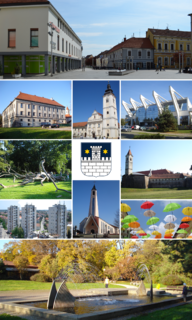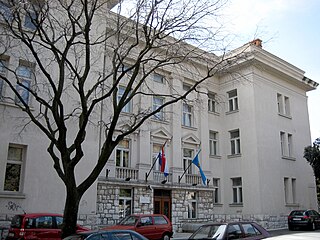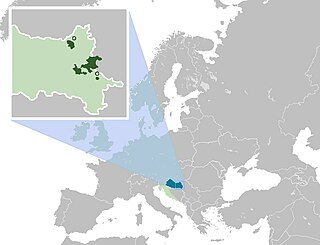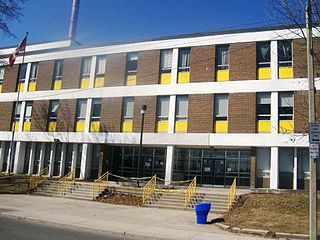See also
Lists of schools in Europe by country | |
|---|---|
| Sovereign states |
|
| States with limited recognition | |
| Dependencies and other entities | |
School education in Croatia is mainly provided by the Ministry of Education of the Croatian Government. The Constitution of Croatia section 65 defines primary and secondary education as mandatory and free.

Croatia, officially the Republic of Croatia, is a country at the crossroads of Central and Southeast Europe. It shares a coastline along the Adriatic Sea, and borders Slovenia to the northwest, Hungary to the northeast, Serbia to the east, Bosnia and Herzegovina and Montenegro to the southeast, and shares a maritime border with Italy to the west and southwest. Croatia's capital and largest city, Zagreb, forms one of the country's primary subdivisions, with twenty counties. The country spans an area of 56,594 square kilometres, with a population of nearly 3.9 million.

The demographic characteristics of the population of Croatia are known through censuses, normally conducted in ten-year intervals and analysed by various statistical bureaus since the 1850s. The Croatian Bureau of Statistics has performed this task since the 1990s. The latest census in Croatia was performed in autumn of 2021. According to preliminary results published mid-January 2022 the permanent population of Croatia at the 2021 census had reached 3.89 million. The population density is 68.7 inhabitants per square kilometre, and the overall life expectancy in Croatia at birth was 78,2 years in 2018. The population rose steadily from 2.1 million in 1857 until 1991, when it peaked at 4.7 million. Since 1991, Croatia's death rate has continuously exceeded its birth rate; the natural growth rate of the population is negative. Croatia is in the fourth stage of the demographic transition. In terms of age structure, the population is dominated by the 15 to 64 year‑old segment. The median age of the population is 43.4, and the gender ratio of the total population is 0.93 males per 1 female.

Čakovec is a city in northern Croatia, located around 90 kilometres north of Zagreb, the Croatian capital. Čakovec is both the county seat and the largest city of Međimurje County, the northernmost, smallest and most densely populated Croatian county.

A secondary school describes an institution that provides secondary education and also usually includes the building where this takes place. Some secondary schools provide both lower secondary education and upper secondary education i.e. levels 2 and 3 of the ISCED scale, but these can also be provided in separate schools, as in the American middle and high school system. In the UK, most state schools and privately-funded schools accommodate pupils between the ages of 11-16 or 11–18. Some elite UK private schools, i.e. public schools, admit pupils between the ages of 13 and 18.

The University of Zagreb is the largest Croatian university and the oldest continuously operating university in the area covering Central Europe south of Vienna and all of Southeastern Europe.

Metković is a town in the Dubrovnik-Neretva County of Croatia, located in the southeast of the country, on the banks of the river Neretva and on the border with Bosnia and Herzegovina.

The University of Rijeka is in the city of Rijeka with faculties in cities throughout the regions of Primorje, Istria and Lika.

Dragan Primorac is a Croatian physician, geneticist and forensic scientist. He is the first recipient of the title “Global Penn State University Ambassador”. Currently, he serves as the Chair of the International Affairs Committee of the American Academy of Forensic Sciences and as President of the International Society for Applied Biological Sciences. He is a member of the International Consortium for Personalised Medicine Executive Committee established by The European Commission. In November 2015 he was elected to lead the State competitiveness cluster in personalized medicine while in 2018 he was elected to lead the Croatian Society for Human Genetics and in 2019 the Croatian Society for Personalised Medicine. In March of 2021. he is appointed as Professor Emeritus at National Forensic Sciences University in India.
Education in Croatia is a right defended by Article 66 of the Constitution which states that everyone is entitled to free compulsory education under equal conditions and in accordance with their aptitudes. Education is mandatory for children aged 6 to 14.

The following outline is provided as an overview of and topical guide to Croatia:

The Archdiocesan Classic Gymnasium is a Catholic high school located on 106 Voćarska Road in the neighborhood of Šalata in Zagreb, Croatia. The school implements a program highlighting the classical culture and history, having students learn the Latin and the Ancient Greek. The school promotes Catholicism and serves as a public preparatory school for the Interdiocesan Boys' Seminary, a seminary for future Catholic priests located in the same building complex.

The Kantakuzina Katarina Branković Serbian Orthodox Secondary School, abbreviated as SPOG, is a coeducational gymnasium of the Metropolitanate of Zagreb and Ljubljana located in Zagreb, Croatia. It is the only non-seminary high school of the Serbian Orthodox Church in the former Yugoslavia.

The Joint Council of Municipalities in Croatia is an elected consultative sui generis body which constitutes a form of cultural self-government of Serbs in the eastern Croatian Podunavlje region. The body was established in the initial aftermath of the Croatian War of Independence as a part of the international community's efforts to peacefully settle the conflict in self-proclaimed Eastern Slavonia, Baranya and Western Syrmia. The establishment of the ZVO was one of the explicit provisions of the Erdut Agreement which called upon the United Nations to establish its UNTAES transitional mission.

Dalj High School is a public high school in Dalj, Croatia. The school offers the students the following educational programs: Economist, Commercial Officer, Agricultural Technician and Agricultural Technician General. In accordance with rights derived from Erdut Agreement Serbian minority in this school use right of education in minority language. For this reason, students can attend classes in Croatian or Serbian language and Serbian Cyrillic alphabet.

West Park Secondary School, originally known as West Park Vocational School is a Toronto District School Board public high school facility that operated as a regular school from 1968 to 1988 by the Toronto Board of Education from grade 9 to 13. The school offered various vocational and academic courses in the spacious four-storey school building for inner city schools. The property remains under TDSB possession as of 2019 as a holding school.

Brockton High School is a Toronto District School Board learning complex based in the Brockton Village neighbourhood of Toronto, Ontario, Canada that once operated as Brockton Learning Centre consisting of the Aboriginal Education Centre and the Caring and Safe Schools Brockton program. It was formerly a public and vocational high school operated from 1967 to 1995 by the Toronto Board of Education. The Brockton property, located near Dufferin Mall, is currently owned by the Toronto Lands Corporation, a realtor arm of the school board.

Antun Vrančić High School(Croatian: Gimnazija Antuna Vrančića) is a public 4-year general-education high school in Šibenik, Croatia. It currently offers programs focusing on mathematics and natural sciences, classics, linguistics, as well as a general-track program. The school was named after Antun Vrančić (1504-1573), a native of Šibenik.

Education in Kosovo is carried out in public and private institutions. Starting from 1999, education in Kosovo was subject to reforms at all levels: from preschool education up to university level. These reforms aimed at adjusting the education in Kosovo according to European and global contemporary standards. As a first step of this new system is considered the establishment of the Department of Education and Science (DES), which is followed with the creation of legal and professional infrastructure, which should facilitate the fundamental reformation of the education, and the establishment of the Ministry of Education, Science and Technology (MEST) in March 2002. During this period the private education system began to develop.